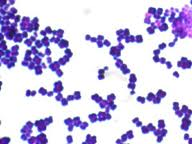Aerococcus urinae
Aerococcus urinae
Classification
- Phylum: Bacteria
- Genus: Aerococcus
- Species: Aerococcus urinae
Description and Significance
- Aerococcus urinae (A.urinae) is a rare bacterium that can occur in a urinary tract infection, infective endocarditis, blood stream, and spinal disc infections. A. urinae is a gram-positive coccus occurring in tetrads or pairs, similar to the α-hemolytic Streptococci, which is commonly found in the urinary tract in children and elderly people.
Pathology
- A. urinae has been known to cause invasive infections such as endocarditis (pertains to the inflammation of the heart), spondylodiscitis (pertains to the inflammation of 2 or more vertebrae), speticaemia ( pertains to blood poisoning), and cellulitus (pertains to a bacterial skin infection). Aerococcus urinae naturally occurs in dust, air, vegetation, and hospital environments. This bacterium occurs in three cases per million habitants per year.
Diagnosis
- The diagnosis of A. urinae is often missed in many laboratories around the world due to many strains of Aerococcus species, A.urinae being the least common. Differentiating between A. urinae and streptococci can be difficult to distinguish apart because they both characterize a cocci appearance either tetrads or clusters. Techniques such as 16s rRNA sequencing, Vitek (a type of gene sequencing analysis), and DNA-DNA relatednesss investigations can be used in diagnosis of A. urinae. These particular tests are used due to the homogenous characteristics of A. urinae.
Treatment
- A. urinae is resistant to Trimethoprim-Sulfamthoxazole (SXT) and Ciprofloxacin, an antibiotic used to treat A. urinae. SXT was commonly used as an empirical drug of choice for treatment of A. urinae which is not as effective as beta-lactam. Beta-lactam and penicillin is the primary antibiotic used to treat A. urinae but fluroquinolones and clindamycin have also been used. Penicillin is the drug used to treat patients who have endocarditis. Patients are advised to take it for six weeks along with aminoglycoside (a sugar based antibiotic) for the first 14 days.
References
1. Anigeet, H., Bell, A., Imran, M., Livesley, P., Pai, P. A Case Report of Successful Management of Aerococcus urinae Peritonitis in a Patient on Peritoneal Dialysis. Nov/Dec, 30(6):661- 662.
2. Christensen JJ, Kilian M, Fussing V, Andresen K, Blom J, Korner B, Streigerwalt AG, Aerococcus urinae: polyphasic characterization of the species. APMIS 2005; 113: 517-25.
3. Grude, N., Jenkins, A., Tveten, Y. and Kristiansen, B.-E. (2003), Identification of Aerococcus urinae in urine samples. Clinical Microbiology and Infection, 9: 976–979. doi: 10.1046/j.1469- 0691.2003.00704.x
4. Hindler, Janet A., Humphries, Romney M., Lee, Courtney. Aerococcus urinae and Trimethoprim-Sulfamethoxazole. Journal of Clinical Microbiology. Nov 2011. 49(11):3934-3935.
5. Senneby, E. , Petersson, A. C. , Rasmussen, M. Clinical and microbial features of bacteraemia with Aerococcus urinae. Clin Microbiol Infect 2012; 18: 546-550
6. Yu, Victor L., Rainer Weber, Didier Raoult, John H. Rex, and Meena H. Seenivasan. "Aerococcus Urinae." Antimicrobial Therapy and Vaccines. 2nd ed. New York, N. Y.: Apple Tree Productions, LLC, 2002. N. pag. Print.

